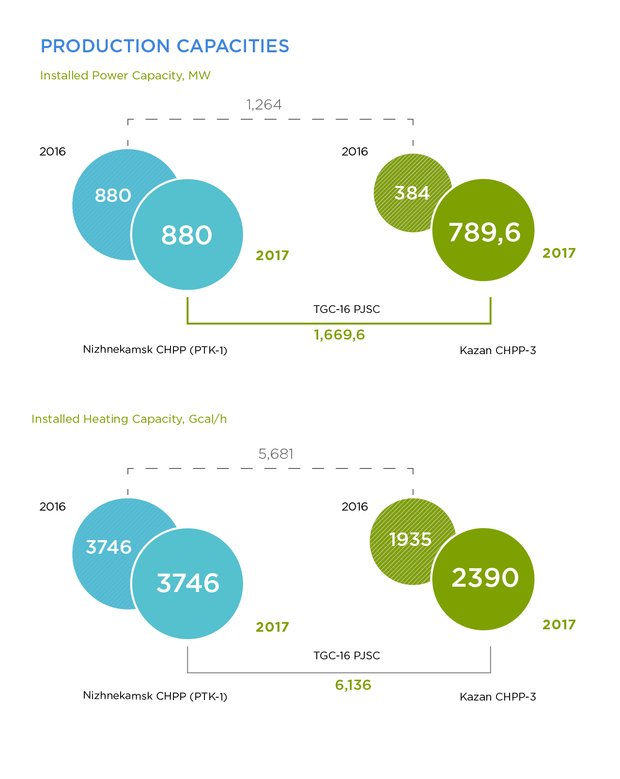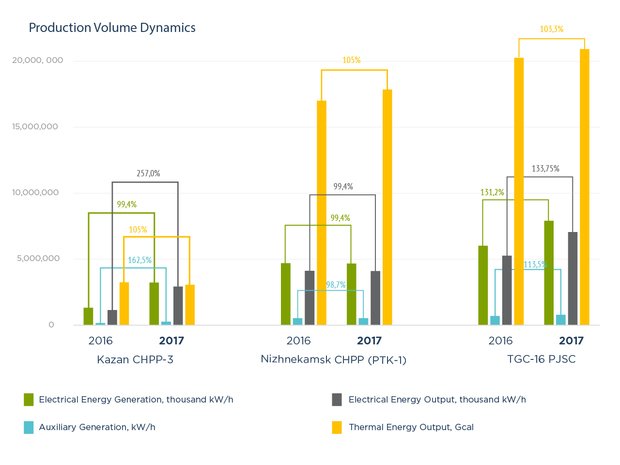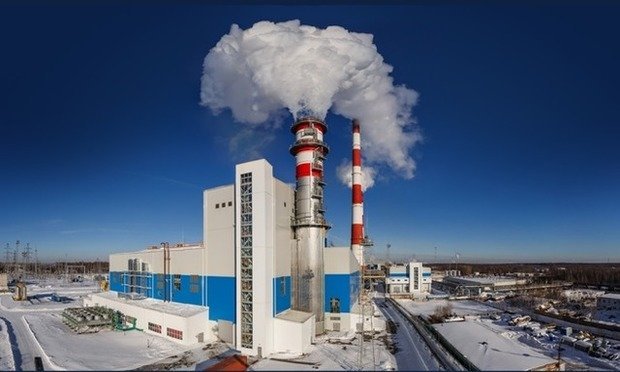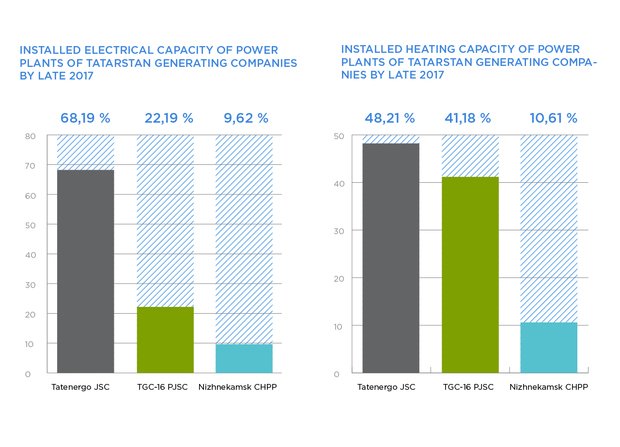Energy of growth: TGC-16 increases revenue and production indicators
The company drew conclusions of last year’s work
The launch of a unique energy unit, an increase of revenue, implementation of Industry 4.0 – this is how 2017 ended for one of the biggest energy enterprises of Tatarstan TGC-16 PJSC. And if the previous period was marked for the economy for world sanctions, growth in costs, reduction of investments and rise in the number of debtors, TGC-16 managed to demonstrate a positive dynamics and stable operation in the market. Realnoe Vremya found out what other results TAIF power engineers could achieve in 2017.
31,2% production growth
''In 2017, we managed to achieve all tasks we had. The company actively augmented production volumes by providing energy security of consumers and implementing innovative technologies,'' says Director General of TGC-16 Eduard Galeyev while estimating the activity's results. In general, the milestone significantly affected the dynamics of the company's results – the launch of a powerful turbine in the Kazan CHPP-3. As a result, the installed capacity of generating facilities of the company increased by 405,6 MW.

Electrical energy generation at TGC-16 in 2017 was 7,9 billion kilowatt-hours (kW) and increased by 31,2% in comparison with the last year. 7,1 billion kW of this volume was sent to the grid, the enterprise spent 0,9bn kW for its own needs. The company managed to achieve such results increasing indicators in the Kazan CHPP-3, which doubled its installed capacity after reconstruction and tripled electrical energy generation. In general, the combined heat and power plant generated 3,2 billion kW (last year, this indicator was 1,3bn kW). Another office of the company, Nizhnekamsk CHPP (PTK-1), generated, 4,7bn kWt of electrical energy in 2017.
Heating energy generation of the Kazan CHPP-3 and Nizhnekamsk CHPP (PTK-1) in 2017 totalled 20,9 million Gcal, which is 3% more than the level in 2016.

Unjustified imbalance
Despite the growth of heat consumption of industrial enterprises of the city, the issue of additional heating energy output in the Kazan CHPP-3 still remains topical. We should remind that representatives of the company have claimed many times about the problem of unequal load distribution in the heating energy market, which, in fact, violated the Federal Law No. 190 – FL ''On Heating''.
In conditions of the lack of capacities and high heat tariffs for the population, the capacities of the biggest Kazan combined heat and power plant aren't almost used. According to TGC-16, Tatenergo JSC deliberately violated the core normative document in the centralised heating system of Kazan – the city's Heat Supply System. In addition, the company doesn't use a considerable volume of existing heating capacity of the cheapest CHPP of Kazan. If in 2013 the KCHPP-3 supplied 1,5m Gcal a year to heat the city, now heat generation in Tatenergo networks is just 700,000 Gcal. It's 30% less than installed in Kazan's Heat Supply System. The doubtful situation brought the energy giants to the Federal Anti-Monopoly Service. However, the problematic situation remained in the air.

Now Kazan is waiting for a new Heat Supply System. However, the version of the normative document, which the Executive Committee of Kazan sent to the Russian Ministry of Energy for approval, caused many questions among the expert commission of the Russian Ministry of Energy. The model offered by the designer was an obvious imbalance in favour of the real monopolist – Tatenergo. The relative ministry sent the Heat Supply System of Kazan back for a refinement. Now it's unknown what a decision will be made in the end. One thing is clear: if the heating load scheme doesn't change, and it's not redistributed towards a cheaper combined generation source, heat tariffs for citizens of Kazan will keep on growing.
Almost 30% brake specific fuel consumption reduction
Brake specific fuel consumption is one of the key indicators of the success of the plants. It defines how much fuel a combined heat power plant consumes to generate one kilowatt hour of electrical energy as an indicator of the competitiveness of the plant in the electrical energy and capacity wholesale market (EECWM).
Here TGC-16's Nizhnekamsk branch doesn't have equals, so to speak: while many leading plants of the country with the latest equipment fight for 300 g/kWh, the Nizhnekamsk CHPP (PTK-1) reached 237,8 g/kWh in 2017 by annually reducing brake specific fuel consumption for generated electrical energy. The indicator of the Kazan CHPP-3 decreased from 306,3 g/kWh in 2016 to 244,2 g/kWh in 2017.
''An average consumption in the plant will reduce by almost 30% in comparison with 2016. In 2018, an average brake specific fuel consumption in the KCHPP-3 is planned at the level of 215 g/kWh. Such effective fuel use indicators will provide competitiveness to the power plant in the electrical energy market at least in the next 20 years,'' the TGC-16 director general forecasts.

The company sells the whole heating energy according to heating energy and coolant agreements. It's sold to both industrial consumers and heat supply organisations (heat generation in hot water). Kazanorgsintez PJSC, Nizhnekamskneftekhim PJSC, TAIF-NK PJSC, Tatenergo JSC and other big enterprises of Tatarstan are among the major clients of the company. The production volume of electrical energy of TGC-16 PJSC on the basis of regulated agreements didn't exceed the highest level of 35% last year. The geography of electrical energy shipment remained the same – the first price zone of the wholesale market uniting power plants of Central, Southern, Northwest, Ural, Volga, Northern Caucasus Federal Districts.
Expanding financial horizons
We should mention that TGC-16 pays a lot of attention to technical and technological updates. Last year, more than 1 billion rubles were sent for an overhaul campaign. The company carried out necessary major overhauls of two turbine generators, boilers, two transformers and current repairs of the main and auxiliary equipment of the plants.
The total volume of investments made last year to construct new and update current production capacities amounted to 8,9bn rubles. This indicator rose in comparison with the previous accounting period by 3%.
A considerable job was also done in the sphere of technical rearmament of energy facilities, update and reconstruction of equipment, implementation of new equipment. For instance, apart from the significant project for the republic – the launch of the gas turbine unit in the KCHPP-3 – the company became one of the first pilot platforms of Tatarstan in implementing the concept Industry 4.0. During the update of the KCHPP-3, Predix predictive diagnostic system, which is to track and forecast technical failures, was installed in the plant. The platform enables to minimise possible deterioration of the equipment with germinating or developing failures.

In general, the gradual job in energy saving and energy effectiveness enhancement of TGC-16 positively affected the company's financial indicators. So in 2017, sales revenue was 27,4bn rubles, which is 18% more than in 2016. Sale of heating energy and coolant, whose share was 58%, accounted for the greatest part in revenue as well as electrical energy and capacity generation – 41% of total revenue.
A 10% increase in sales profit was a consequence of a revenue growth – to 3,1bn rubles. EDITDA indicator was 4bn rubles. In general, the company paid 1,6bn rubles of taxes and duties to all budget levels and non-budget funds.
As for development prospects, in 2018, TGC-16 plans to continue to pursue the chosen course as a stable, socially oriented company with a high level of responsibility.
''TGC-16 is ready to be flexible and follow new tendencies in power engineering meeting the consumers' needs. The company has possibilities for further development and improvement of financial indicators,'' Eduard Galeyev defines perspectives.